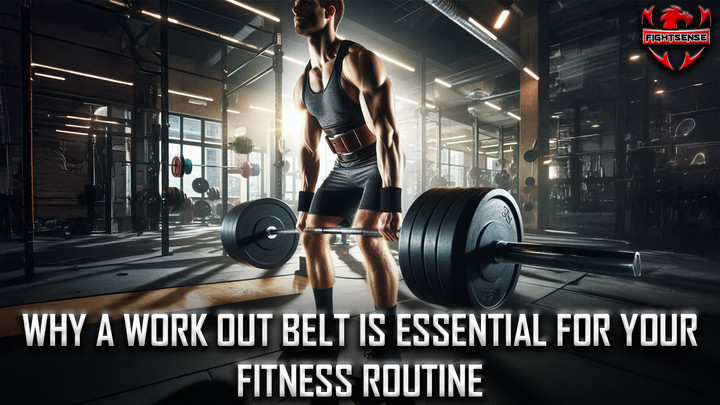Why a Work Out Belt is Essential for Your Fitness Routine
26th Mar 2025
Are you trying to improve your lifting performance and reduce your risk of injury during demanding training? One possible missing secret is a work out belt. Whether your chosen weight training is deadlifts, squats, another variation, a lifting belt provides unparalleled support, comfort, and stability. Designed to help you keep correct posture, avoid injuries, and lift with confidence, this basic gym tool.
We will discuss in this blog the several advantages of wearing a work out belt, how it can increase your lifts, and advice on choosing the appropriate one for your needs.
Key Highlights:
-
A work out belt gives exceptional lower back support during intense lifts.
-
Work lifting belts help to keep proper posture and lower injury risk.
-
Belt workouts are meant to be comfortable and consistent.
-
A work out belt enhances mobility and flexibility by means of its ergonomic fit.
-
Better lifting performance will come from correct lifting work belt.
Why a Work Out Belt is Essential for Your Fitness Routine
A work out belt has applications outside simply accessory value. Particularly when lifting large weights, this device offers extra support and stability, therefore enhancing your performance during the workout. It guarantees that, during demanding workouts like deadlifts and squats, you keep correct form and avoid lower back damage.
Creating intra-abdominal pressure enables you push through more confidently larger lifts by enabling you to anchor your core. Including a working out belt into your program will help you to reach your fitness objectives regardless of your degree of experience: rookie or advanced lifter.
Benefits of Using Work Out Belts
A work lifting belt is essential for anyone looking to maximize their lifting potential. Here are a few reasons why you should consider using one:
-
Enhanced Core Support: During big lifts, work out belts supports your core and aids in spine stabilization, therefore enhancing posture and form.
-
Injury Prevention: Increasing intra-abdominal pressure helps a work out belt protect your lower back and lower back risk is reduced.
-
Improved Performance: Knowing your core is correctly supported can help you to safely raise greater weight with the correct working out belt.
-
Better Focus: A well-fitting lifting belt helps to ease pain, therefore releasing you to concentrate on your lifts rather than on your form.
How to Choose the Right Work Out Belt
Your lifting performance might be much enhanced by work out belt.This is what one should consider:
-
Fit and Comfort: Make sure the belt fits tightly but not overly so. It should give enough support and be in position during your lifts.
-
Material: Look for a sturdy material for your belt such as premium synthetic fabrics or leather. Though synthetic materials give flexibility and breathability, leather is renowned for its strength and solid support.
-
Thickness and Width: The support degree of the belt depends on its thickness. A thicker belt is more appropriate for hard lifting; for less demanding, dynamic tasks, a thinner belt could be more comfortable.
Common Mistakes to Avoid When Using a Working Out Belt
Avoid these typical errors so that your working out belt will be entirely beneficial.
-
Although the belt should assist you, it should not be overly tight since it would make breathing difficult.
-
For greater lifts, use a work out belts instead of a crutch for all workouts. Development of your core is also really crucial.
-
Selecting the wrong size belt could cause discomfort or compromise its functionality. Measure your waist always before you buy anything.
How a Lifting with Work out Belts Improves Your Lifts
Using a workout lifting belt will assist in the following lifting motions:
-
Increased Stability: A lifting work belt helps you to stabilize your core, thereby enabling confident lifting of more weight.
-
Better Posture: Good posture kept by bracing your lower back helps you prevent damage during large lifts.
-
Reduced Fatigue: By preventing core tiredness, a work out belt will help you to finish more sets and repetitions.
Shop Now !
Conclusion:
Anyone really committed to lifting needs a work out belt. Apart from avoiding harm, it gives stability, support, and comfort, so enhancing your whole lifting performance. Investing in a work lifting belt will improve your training and enable you to reach your fitness targets regardless of your level of lifting knowledge.
Disclaimer
This blog has mostly teaching value. Before utilizing any weightlifting equipment, always see a qualified trainer or medical practitioner to be certain it fits your particular demand and degree of fitness.
FAQs
1. Describe an exercise belt.
During tough lifts, a work out belt helps to stabilize your core and lower back.
2. Can I do all of my routines using a work lifting belt?
Although a lifting belt helps with larger lifts like squats and deadlifts, it is not required for cardio or lesser exercises.
3. What range of exercise belts should I go for?
Choose a workout belt that fits your budget, is made of strong material (synthetic or leather), and closely matches your lifting requirements.
4. How closely fitting should a belt used for working out be?
Your workout belt should be tightly fitting without limiting your breathing. It should stay in place during lifts and yet let you flex your diaphragm.
5. Should I use a work lifting belt for every lift?
Although large lifts demand it, they shouldn't be depended upon for every activity. Your basic ability should grow free from it.

